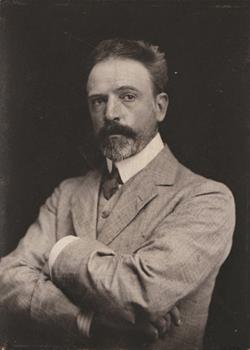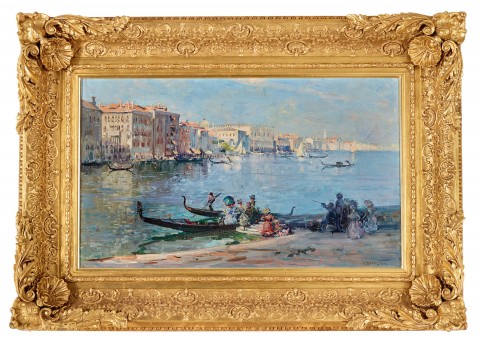BLUE LAGOON, FRINGED ROUND WITH PALACES, c.1908
ARTHUR STREETON
oil on canvas
54.5 x 85.5 cm
signed lower right: A. STREETON
bears inscription with title verso: Blue Lagoon
Mrs C.V.M. Mabbutt, United Kingdom
Private collection
Sotheby’s, London, 22 October 1986, cat. 146
The Dallhold Collection
Christie’s, Melbourne, 28 July 1992, lot 14
Private collection, Sydney
Catalogue of Paintings by Arthur Streeton, The Alpine Club Gallery, London, 26 March 1909, cat. 34 Arthur Streeton's Venice, Guildhall, Melbourne, 13 – 27 July 1909, cat.2 (illus. in exhibition catalogue)
Arthur Streeton 1867 – 1943, National Gallery of Victoria, Melbourne, 8 December 1995 – 12 February 1996; Art Gallery of South Australia, Adelaide, 1 March – 14 April 1996; Art Gallery of Western Australia, Perth, 2 May – 16 June 1996; Queensland Art Gallery, Brisbane, 9 July – 25 August 1996; Art Gallery of New South Wales, Sydney, 7 September – 3 November 1996, cat. 63 (label attached verso)
‘Venice Pictures’, The Herald, Melbourne, 12 July 1909, p. 3
‘Mr Arthur Streeton’s Pictures’, The Age, Melbourne, 13 July 1909, p. 6 (as ‘Blue Lagoon, Fringed with Palaces’)
‘Venice at the Guildhall’, The Argus, Melbourne, 13 July 1909, p. 6 (as ‘Blue Lagoon, Fringed round with Palaces’)
Daily Graphic, London, 6 April 1909 (as ‘Blue Lagoon Fringed Round with Palaces’)
de Bussy, D., The Alan Bond Collection of Australian Art, Dallhold Investments Pty Ltd, Perth, 1990, p. 69 (illus.)
Smith, G., Arthur Streeton 1867 – 1943, exhibition catalogue, National Gallery of Victoria, Melbourne, 1995, pp. 148, 149 (illus.)
PORTRAIT OF ARTHUR STREETON, 1907.jpg

‘He has seen Venice in the happiest of circumstance, when her mirror-like waters and the marble-clad facades of her palaces are sparkling in sunlight, but before the season when the heat of the sun has become too oppressive … the glittering “Blue Lagoon Fringed Round with palaces” [is one of] the most notable among the many pictures here that cannot fail to raise an intense longing for Venice in every visitor’s breast.’1
Arthur Streeton’s extraordinary ability to capture the effects of sunlight in paint is brilliantly expressed in this view of Venice, where reflections on the water and the pastel haze of the sky conjure up the magic and atmosphere of the most romantic of Italian cities. In January 1908 Streeton married Nora Clench – a Canadian violinist he had met in London where they were both working to establish international careers – and in the spring, they honeymooned in Venice. Working outdoors, often surrounded by crowds of inquisitive onlookers, Streeton painted in oil and watercolour, as well as making a series of sketches in pencil and wash which provided reference for works that he developed later in the studio. Paintings produced during and following this visit, as well as a return trip that the couple made in autumn, several months later, depict Piazza San Marco, the Rialto Bridge and numerous other views which feature the canals and striking architecture of the city. Writing later to a friend, Streeton said, ‘… I worked hard and did some good pieces. What a wonderful place it is.’2
In this scene, Streeton looks across the Grand Canal from the vicinity of Santa Maria della Salute, the grand domed Baroque church in the Dorsoduro. A group of elegantly dressed women in the foreground lift the skirts of their Edwardian dresses as they board a waiting gondola, and two others hurry along the embankment to join them. Water dominates and divides the composition, leading the eye from the lower left across to the upper right, where pictorial detail dissolves and the canal mirrors the sky, both elements painted in delicate shades of mauve and white, tinged with an underlying warmth. The artist delights in describing the buildings that line the edge of the opposite bank, the distinctive arched colonnade of the fourteenth century Doge’s Palace centrally placed, and one of the famous domes of San Marco Basilica just visible to its left.
A group of the Venice paintings, including Blue Lagoon, Fringed Round with Palaces, 1908, was exhibited at the Alpine Club in London in March 1909 and received considerable positive attention in the press. Describing Streeton’s brushwork as ‘swift’ and ‘able’, the critics praised the luminosity of his depictions, one writing that ‘they seem … to radiate the light and colour which fills them.’3 Shown later that year at the Guildhall in Melbourne, this painting was similarly praised by the Herald critic for its clever treatment of light and shade, an accolade not surprising for Streeton, a key member of the Australian Impressionists and one of this country’s most important artists.4
1. Daily Graphic, London, 6 April 1909
2. Streeton to Frederick Delmer, 1 July 1908, quoted in Galbally, A. & Gray, A., Letters from Smike, The Letters of Arthur Streeton 1890-1943, Oxford University Press Australia, Melbourne, 1989, p. 113
3. M. Irwin MacDonald, ‘Arthur Streeton’, The Craftsman, Vol. XVII, No. 2, New York, November 1909, p. 163
4. ‘Venice Pictures’, The Herald, Melbourne, 12 July 1909, p. 3
KIRSTY GRANT

